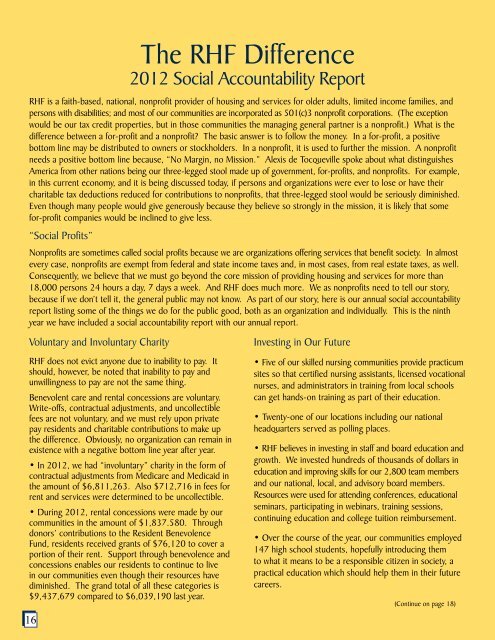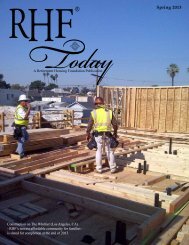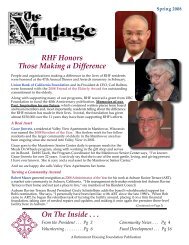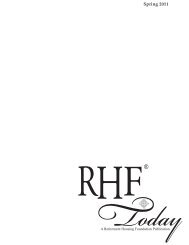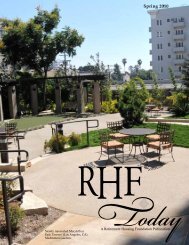Current Annual Report - Retirement Housing Foundation
Current Annual Report - Retirement Housing Foundation
Current Annual Report - Retirement Housing Foundation
- No tags were found...
Create successful ePaper yourself
Turn your PDF publications into a flip-book with our unique Google optimized e-Paper software.
Voluntary and Involuntary CharityRHF does not evict anyone due to inability to pay. Itshould, however, be noted that inability to pay andunwillingness to pay are not the same thing.Benevolent care and rental concessions are voluntary.Write-offs, contractual adjustments, and uncollectiblefees are not voluntary, and we must rely upon privatepay residents and charitable contributions to make upthe difference. Obviously, no organization can remain inexistence with a negative bottom line year after year.• In 2012, we had “involuntary” charity in the form ofcontractual adjustments from Medicare and Medicaid inthe amount of $6,811,263. Also $712,716 in fees forrent and services were determined to be uncollectible.• During 2012, rental concessions were made by ourcommunities in the amount of $1,837.580. Throughdonors’ contributions to the Resident BenevolenceFund, residents received grants of $76,120 to cover aportion of their rent. Support through benevolence andconcessions enables our residents to continue to livein our communities even though their resources havediminished. The grand total of all these categories is$9,437,679 compared to $6,039,190 last year.16The RHF Difference2012 Social Accountability <strong>Report</strong>RHF is a faith-based, national, nonprofit provider of housing and services for older adults, limited income families, andpersons with disabilities; and most of our communities are incorporated as 501(c)3 nonprofit corporations. (The exceptionwould be our tax credit properties, but in those communities the managing general partner is a nonprofit.) What is thedifference between a for-profit and a nonprofit? The basic answer is to follow the money. In a for-profit, a positivebottom line may be distributed to owners or stockholders. In a nonprofit, it is used to further the mission. A nonprofitneeds a positive bottom line because, “No Margin, no Mission.” Alexis de Tocqueville spoke about what distinguishesAmerica from other nations being our three-legged stool made up of government, for-profits, and nonprofits. For example,in this current economy, and it is being discussed today, if persons and organizations were ever to lose or have theircharitable tax deductions reduced for contributions to nonprofits, that three-legged stool would be seriously diminished.Even though many people would give generously because they believe so strongly in the mission, it is likely that somefor-profit companies would be inclined to give less.“Social Profits”Nonprofits are sometimes called social profits because we are organizations offering services that benefit society. In almostevery case, nonprofits are exempt from federal and state income taxes and, in most cases, from real estate taxes, as well.Consequently, we believe that we must go beyond the core mission of providing housing and services for more than18,000 persons 24 hours a day, 7 days a week. And RHF does much more. We as nonprofits need to tell our story,because if we don’t tell it, the general public may not know. As part of our story, here is our annual social accountabilityreport listing some of the things we do for the public good, both as an organization and individually. This is the ninthyear we have included a social accountability report with our annual report.Investing in Our Future• Five of our skilled nursing communities provide practicumsites so that certified nursing assistants, licensed vocationalnurses, and administrators in training from local schoolscan get hands-on training as part of their education.• Twenty-one of our locations including our nationalheadquarters served as polling places.• RHF believes in investing in staff and board education andgrowth. We invested hundreds of thousands of dollars ineducation and improving skills for our 2,800 team membersand our national, local, and advisory board members.Resources were used for attending conferences, educationalseminars, participating in webinars, training sessions,continuing education and college tuition reimbursement.• Over the course of the year, our communities employed147 high school students, hopefully introducing themto what it means to be a responsible citizen in society, apractical education which should help them in their futurecareers.(Continue on page 18)


